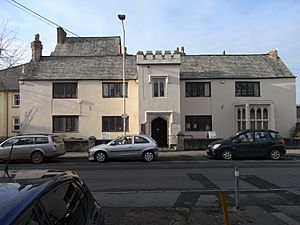Barnstaple Priory facts for kids
The Priory of St Mary Magdalene was a special religious building in Barnstaple, Devon, England. It was like a monastery, but usually smaller, where monks lived and prayed. This priory was started around 1107 by a powerful lord named Juhel de Totnes. He was the feudal baron of Barnstaple, which meant he was the main ruler of the area. Juhel had also started another priory in Totnes earlier.
Barnstaple Priory belonged to the Cluniac order. This was a very important group of monks known for their strict rules and focus on prayer. In fact, Barnstaple Priory was one of the most important Cluniac priories in England! It was named after St Mary Magdalene. The priory was built just outside the old town walls of Barnstaple, near the River Yeo. Close by, across the river, was another religious house called Benedictine Pilton Priory.
What the Priory Owned
When Juhel de Totnes started the priory, he gave it many valuable things. He gave it some of his own land from Barnstaple Castle. He also gave the priory parts of the nearby areas called Pilton and Pilland. These lands were very important for growing food and supporting the monks.
The priory also received rights to the wood, water, and meadows in Pilton. This included the right to fish in the Rivers Taw and Yeo, which was a great way to get food. Juhel also gave the priory the Barnstaple town mill. This meant everyone in Barnstaple had to grind their grain at the priory's mill, and the priory earned money from this.
The priory was also given the Church of St Peter in Barnstaple. This was the main church in the town. There was also a Chapel of St Sabinus given to the priory, but we don't know exactly where it was located today. Juhel even said in his founding document that he hoped to become a monk at the priory himself!
When the Priory Closed Down
The Priory of St Mary Magdalene didn't last forever. In the 1500s, King Henry VIII decided to close down many monasteries and priories across England. This event is known as the Dissolution of the Monasteries.
After the priory was closed, King Henry VIII first leased its lands to William Howard, 1st Baron Howard of Effingham. Later, he gave the lands to William Howard completely. The Howard family owned these lands until 1609. Then, William Howard, Lord Howard of Effingham started selling off parts of the land. Many of the larger pieces of land in Pilton and Bradiford were bought by Henry Rolle.
The Barnstaple Vicarage House
The Vicarage House in Barnstaple was originally built in 1311. It was located right at the entrance of the priory. The building you can see today (which is used as a dentist's office) was largely rebuilt. This happened during the English Civil War by a vicar named Rev Martin Blake. He spent a lot of his own money to rebuild it. Rev Blake was the vicar of Barnstaple from 1628-1656 and again from 1660-1673. He faced many difficulties because he supported the King during the Civil War. Later, in the 1800s, more parts were added and restored by other vicars, Rev Henry Luxmore and Rev Gilbert Innes Wallas.



